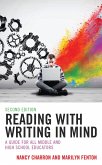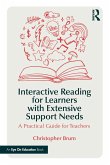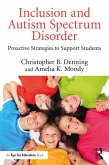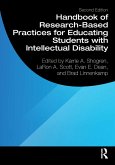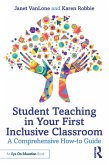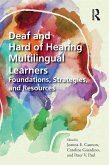Nancy Charron, Marilyn Fenton
Reading with Writing in Mind (eBook, ePUB)
A Guide for All Middle and High School Educators
21,95 €
21,95 €
inkl. MwSt.
Sofort per Download lieferbar

11 °P sammeln
21,95 €
Als Download kaufen

21,95 €
inkl. MwSt.
Sofort per Download lieferbar

11 °P sammeln
Jetzt verschenken
Alle Infos zum eBook verschenken
21,95 €
inkl. MwSt.
Sofort per Download lieferbar
Alle Infos zum eBook verschenken

11 °P sammeln
Nancy Charron, Marilyn Fenton
Reading with Writing in Mind (eBook, ePUB)
A Guide for All Middle and High School Educators
- Format: ePub
- Merkliste
- Auf die Merkliste
- Bewerten Bewerten
- Teilen
- Produkt teilen
- Produkterinnerung
- Produkterinnerung
- Weitere 7 Ausgaben:
- Gebundenes Buch
- Gebundenes Buch
- Broschiertes Buch
- Broschiertes Buch
- eBook, ePUB
- eBook, PDF
- eBook, PDF

Bitte loggen Sie sich zunächst in Ihr Kundenkonto ein oder registrieren Sie sich bei
bücher.de, um das eBook-Abo tolino select nutzen zu können.
Hier können Sie sich einloggen
Hier können Sie sich einloggen
Sie sind bereits eingeloggt. Klicken Sie auf 2. tolino select Abo, um fortzufahren.

Bitte loggen Sie sich zunächst in Ihr Kundenkonto ein oder registrieren Sie sich bei bücher.de, um das eBook-Abo tolino select nutzen zu können.
Reading with Writing in Mind meets the needs of school districts and teachers by providing rationale and activities that increase students' literacy skills. Relevant reading and writing standards are aligned with Common Core Standards and preface each chapter's activities. Textboxes provide adaptation ideas for students with moderate to severe special needs, English language learners, or low performing students. Readers will explore and implement reading strategies that enhance students' writing across the curriculum.
- Geräte: eReader
- ohne Kopierschutz
- eBook Hilfe
Andere Kunden interessierten sich auch für
![Reading with Writing in Mind (eBook, PDF) Reading with Writing in Mind (eBook, PDF)]() Nancy CharronReading with Writing in Mind (eBook, PDF)21,95 €
Nancy CharronReading with Writing in Mind (eBook, PDF)21,95 €![Word Aware 2 (eBook, ePUB) Word Aware 2 (eBook, ePUB)]() Stephen ParsonsWord Aware 2 (eBook, ePUB)54,95 €
Stephen ParsonsWord Aware 2 (eBook, ePUB)54,95 €![Interactive Reading for Learners with Extensive Support Needs (eBook, ePUB) Interactive Reading for Learners with Extensive Support Needs (eBook, ePUB)]() Christopher BrumInteractive Reading for Learners with Extensive Support Needs (eBook, ePUB)24,95 €
Christopher BrumInteractive Reading for Learners with Extensive Support Needs (eBook, ePUB)24,95 €![Inclusion and Autism Spectrum Disorder (eBook, ePUB) Inclusion and Autism Spectrum Disorder (eBook, ePUB)]() Christopher B. DenningInclusion and Autism Spectrum Disorder (eBook, ePUB)29,95 €
Christopher B. DenningInclusion and Autism Spectrum Disorder (eBook, ePUB)29,95 €![Handbook of Research-Based Practices for Educating Students with Intellectual Disability (eBook, ePUB) Handbook of Research-Based Practices for Educating Students with Intellectual Disability (eBook, ePUB)]() Handbook of Research-Based Practices for Educating Students with Intellectual Disability (eBook, ePUB)103,95 €
Handbook of Research-Based Practices for Educating Students with Intellectual Disability (eBook, ePUB)103,95 €![Student Teaching in Your First Inclusive Classroom (eBook, ePUB) Student Teaching in Your First Inclusive Classroom (eBook, ePUB)]() Janet VanloneStudent Teaching in Your First Inclusive Classroom (eBook, ePUB)22,95 €
Janet VanloneStudent Teaching in Your First Inclusive Classroom (eBook, ePUB)22,95 €![Deaf and Hard of Hearing Multilingual Learners (eBook, ePUB) Deaf and Hard of Hearing Multilingual Learners (eBook, ePUB)]() Deaf and Hard of Hearing Multilingual Learners (eBook, ePUB)39,95 €
Deaf and Hard of Hearing Multilingual Learners (eBook, ePUB)39,95 €-
-
-
Reading with Writing in Mind meets the needs of school districts and teachers by providing rationale and activities that increase students' literacy skills. Relevant reading and writing standards are aligned with Common Core Standards and preface each chapter's activities. Textboxes provide adaptation ideas for students with moderate to severe special needs, English language learners, or low performing students. Readers will explore and implement reading strategies that enhance students' writing across the curriculum.
Produktdetails
- Produktdetails
- Verlag: Bloomsbury eBooks US
- Seitenzahl: 200
- Erscheinungstermin: 16. August 2023
- Englisch
- ISBN-13: 9781475872811
- Artikelnr.: 67973028
- Verlag: Bloomsbury eBooks US
- Seitenzahl: 200
- Erscheinungstermin: 16. August 2023
- Englisch
- ISBN-13: 9781475872811
- Artikelnr.: 67973028
- Herstellerkennzeichnung Die Herstellerinformationen sind derzeit nicht verfügbar.
Nancy Charron has worked as a general education teacher, special education teacher, and literacy specialist for grades K-12. She presently teaches graduate education courses for Southern New Hampshire University.
Marilyn Fenton has taught writing and literature at both high school and college levels as well as prepared prospective language arts teachers at all levels. She taught English in several high schools and oversaw curriculum and instruction as a high school administrator.
Marilyn Fenton has taught writing and literature at both high school and college levels as well as prepared prospective language arts teachers at all levels. She taught English in several high schools and oversaw curriculum and instruction as a high school administrator.
Preface
Introduction
Chapter 1: Reading to Improve Student Writing
Activity 1.1: Take Time to Notice-Looking and Learning
Activity 1.2: Take Time to Notice-An Artist's Choices
Activity 1.3: Take Time to Notice-Comparison of Two Works of Art
Activity 1.4: Noticing the Writer's Choices-Reading Poems
Activity 1.5: Noticing the Writer's Choices-Reading Fiction
Activity 1.6: Noticing the Writer's Choices-Reading Nonfiction
Activity 1.7: Determining Connotation vs. Denotation-Taking the Temperature
of Words
Activity 1.8: Identifying Three Kinds of Questions
Activity 1.9: Using the I-Search Paper
Chapter 2: Reading and Writing in the Content Areas
Activity 2.1: Using the SOAPSTone Strategy
Activity 2.2: Role-playing
Activity 2.3: Using Primary Documents
Activity 2.4: Using Letters, Diaries, and Other Primary Sources
Activity 2.5: Applying the Concept of Essential Questions in Content Areas
Activity 2.6: Implementing Socratic Seminars
Activity 2.7: Reviewing the Textbook
Activity 2.8: Journaling
Activity 2.9: Authentic Content Area Writing
Chapter 3: Developing Focus and Logic through the Essay
Activity 3.1: How Meaning is Constructed in E.B. White's "Once More to the
Lake"
Activity 3.2: Form Supports Meaning
Activity 3.3: Conversion of a Narrative to an Essay
Activity 3.4: Finding Significance in Literature
Activity 3.5: Brainstorming in Response to Essential Questions
Chapter 4: Reading for Persuasive Writing: The Argument
Activity 4.1: Checklist for Close-Reading
Activity 4.2: The Face-Off
Activity 4.3: The Scaffolded Oral Presentation
Activity 4.4: A Panel Discussion
Activity 4.5: Staging the Trial
Activity 4.6: Defending Preference
Chapter 5: Learning to Write by Reading Poetry
Activity 5.1: Less is More
Activity 5.2: "Found" Poetry
Activity 5.3: From Prose to Poetry
Activity 5.4: Playing with Meter
Activity 5.5: Learning from e.e. cummings
Activity 5.6: Poems Using Metaphor
Activity 5.7: Letter Poem
Activity 5.8: History and Poetry
Activity 5.9: Songs as Poetry
Activity 5:10: Inference
Chapter 6: Providing Literacy Access to All Students
Chapter 7: Reading and Reflecting on One's Own Writing
Chapter 8: Closing the Literacy Loop
References
About the Authors
Introduction
Chapter 1: Reading to Improve Student Writing
Activity 1.1: Take Time to Notice-Looking and Learning
Activity 1.2: Take Time to Notice-An Artist's Choices
Activity 1.3: Take Time to Notice-Comparison of Two Works of Art
Activity 1.4: Noticing the Writer's Choices-Reading Poems
Activity 1.5: Noticing the Writer's Choices-Reading Fiction
Activity 1.6: Noticing the Writer's Choices-Reading Nonfiction
Activity 1.7: Determining Connotation vs. Denotation-Taking the Temperature
of Words
Activity 1.8: Identifying Three Kinds of Questions
Activity 1.9: Using the I-Search Paper
Chapter 2: Reading and Writing in the Content Areas
Activity 2.1: Using the SOAPSTone Strategy
Activity 2.2: Role-playing
Activity 2.3: Using Primary Documents
Activity 2.4: Using Letters, Diaries, and Other Primary Sources
Activity 2.5: Applying the Concept of Essential Questions in Content Areas
Activity 2.6: Implementing Socratic Seminars
Activity 2.7: Reviewing the Textbook
Activity 2.8: Journaling
Activity 2.9: Authentic Content Area Writing
Chapter 3: Developing Focus and Logic through the Essay
Activity 3.1: How Meaning is Constructed in E.B. White's "Once More to the
Lake"
Activity 3.2: Form Supports Meaning
Activity 3.3: Conversion of a Narrative to an Essay
Activity 3.4: Finding Significance in Literature
Activity 3.5: Brainstorming in Response to Essential Questions
Chapter 4: Reading for Persuasive Writing: The Argument
Activity 4.1: Checklist for Close-Reading
Activity 4.2: The Face-Off
Activity 4.3: The Scaffolded Oral Presentation
Activity 4.4: A Panel Discussion
Activity 4.5: Staging the Trial
Activity 4.6: Defending Preference
Chapter 5: Learning to Write by Reading Poetry
Activity 5.1: Less is More
Activity 5.2: "Found" Poetry
Activity 5.3: From Prose to Poetry
Activity 5.4: Playing with Meter
Activity 5.5: Learning from e.e. cummings
Activity 5.6: Poems Using Metaphor
Activity 5.7: Letter Poem
Activity 5.8: History and Poetry
Activity 5.9: Songs as Poetry
Activity 5:10: Inference
Chapter 6: Providing Literacy Access to All Students
Chapter 7: Reading and Reflecting on One's Own Writing
Chapter 8: Closing the Literacy Loop
References
About the Authors
Preface
Introduction
Chapter 1: Reading to Improve Student Writing
Activity 1.1: Take Time to Notice-Looking and Learning
Activity 1.2: Take Time to Notice-An Artist's Choices
Activity 1.3: Take Time to Notice-Comparison of Two Works of Art
Activity 1.4: Noticing the Writer's Choices-Reading Poems
Activity 1.5: Noticing the Writer's Choices-Reading Fiction
Activity 1.6: Noticing the Writer's Choices-Reading Nonfiction
Activity 1.7: Determining Connotation vs. Denotation-Taking the Temperature
of Words
Activity 1.8: Identifying Three Kinds of Questions
Activity 1.9: Using the I-Search Paper
Chapter 2: Reading and Writing in the Content Areas
Activity 2.1: Using the SOAPSTone Strategy
Activity 2.2: Role-playing
Activity 2.3: Using Primary Documents
Activity 2.4: Using Letters, Diaries, and Other Primary Sources
Activity 2.5: Applying the Concept of Essential Questions in Content Areas
Activity 2.6: Implementing Socratic Seminars
Activity 2.7: Reviewing the Textbook
Activity 2.8: Journaling
Activity 2.9: Authentic Content Area Writing
Chapter 3: Developing Focus and Logic through the Essay
Activity 3.1: How Meaning is Constructed in E.B. White's "Once More to the
Lake"
Activity 3.2: Form Supports Meaning
Activity 3.3: Conversion of a Narrative to an Essay
Activity 3.4: Finding Significance in Literature
Activity 3.5: Brainstorming in Response to Essential Questions
Chapter 4: Reading for Persuasive Writing: The Argument
Activity 4.1: Checklist for Close-Reading
Activity 4.2: The Face-Off
Activity 4.3: The Scaffolded Oral Presentation
Activity 4.4: A Panel Discussion
Activity 4.5: Staging the Trial
Activity 4.6: Defending Preference
Chapter 5: Learning to Write by Reading Poetry
Activity 5.1: Less is More
Activity 5.2: "Found" Poetry
Activity 5.3: From Prose to Poetry
Activity 5.4: Playing with Meter
Activity 5.5: Learning from e.e. cummings
Activity 5.6: Poems Using Metaphor
Activity 5.7: Letter Poem
Activity 5.8: History and Poetry
Activity 5.9: Songs as Poetry
Activity 5:10: Inference
Chapter 6: Providing Literacy Access to All Students
Chapter 7: Reading and Reflecting on One's Own Writing
Chapter 8: Closing the Literacy Loop
References
About the Authors
Introduction
Chapter 1: Reading to Improve Student Writing
Activity 1.1: Take Time to Notice-Looking and Learning
Activity 1.2: Take Time to Notice-An Artist's Choices
Activity 1.3: Take Time to Notice-Comparison of Two Works of Art
Activity 1.4: Noticing the Writer's Choices-Reading Poems
Activity 1.5: Noticing the Writer's Choices-Reading Fiction
Activity 1.6: Noticing the Writer's Choices-Reading Nonfiction
Activity 1.7: Determining Connotation vs. Denotation-Taking the Temperature
of Words
Activity 1.8: Identifying Three Kinds of Questions
Activity 1.9: Using the I-Search Paper
Chapter 2: Reading and Writing in the Content Areas
Activity 2.1: Using the SOAPSTone Strategy
Activity 2.2: Role-playing
Activity 2.3: Using Primary Documents
Activity 2.4: Using Letters, Diaries, and Other Primary Sources
Activity 2.5: Applying the Concept of Essential Questions in Content Areas
Activity 2.6: Implementing Socratic Seminars
Activity 2.7: Reviewing the Textbook
Activity 2.8: Journaling
Activity 2.9: Authentic Content Area Writing
Chapter 3: Developing Focus and Logic through the Essay
Activity 3.1: How Meaning is Constructed in E.B. White's "Once More to the
Lake"
Activity 3.2: Form Supports Meaning
Activity 3.3: Conversion of a Narrative to an Essay
Activity 3.4: Finding Significance in Literature
Activity 3.5: Brainstorming in Response to Essential Questions
Chapter 4: Reading for Persuasive Writing: The Argument
Activity 4.1: Checklist for Close-Reading
Activity 4.2: The Face-Off
Activity 4.3: The Scaffolded Oral Presentation
Activity 4.4: A Panel Discussion
Activity 4.5: Staging the Trial
Activity 4.6: Defending Preference
Chapter 5: Learning to Write by Reading Poetry
Activity 5.1: Less is More
Activity 5.2: "Found" Poetry
Activity 5.3: From Prose to Poetry
Activity 5.4: Playing with Meter
Activity 5.5: Learning from e.e. cummings
Activity 5.6: Poems Using Metaphor
Activity 5.7: Letter Poem
Activity 5.8: History and Poetry
Activity 5.9: Songs as Poetry
Activity 5:10: Inference
Chapter 6: Providing Literacy Access to All Students
Chapter 7: Reading and Reflecting on One's Own Writing
Chapter 8: Closing the Literacy Loop
References
About the Authors

